
Tourism Places In dausaBest time to visit : October To March Weather: In Summer:45 C (Max) - 25 C (Min) In winter: 22 C (Max) - 8 C (Min) Rainfall in dausa: 55.2 cms.July to Mid Sept Location: 54-km From Jaipur, Rajasthan Significance: Known for Archaeological Importance THE ANCIENT TOWN Situated on National Highway No. 11, 54-km east of Jaipur, dausa is an ancient town of archaeological importance. It had the privilege of being one of the erstwhile kingdoms of Kachhawah rulers of Dhundhar. An old fort and many havelis are located in and around dausa. dausa is a very ancient place. Carlyle in the year 1871-72 AD found a number of stone circles on the sloping ground to the north of the foot of the hill. One or two of them contained cromlechs, a few cairns and sepulchral mound of prehistoric date. Daya Ram Sahni, an archaeologist, also visited dausa and discovered other interesting antiquities, which are believed to belong to the late medieval period. The excavations include a collection of some 40 or 50 fragments of stone images of some of the principal Hindu gods and goddesses. ABHANERI 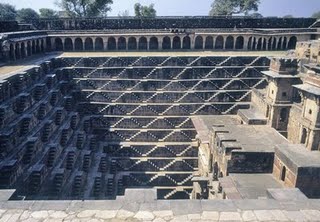 Abhaneri, in the dausa district of Rajasthan, used to be an important village in the ancient times. The sculpture and architecture suggest that it must have been a great centre of arts. But the flourishing town was ruined by none other than the early 11th century plunderer Mahmud Ghazni in one of his invasions (see History of Delhi for more on Ghazni.)
Abhaneri is famous for its Post-gupta or early medieval monuments. Itis situated at about 33 Kms from the district headquarter towards Bandikui. The Chand Baori(Step Well) and Harshat Mata Temple are the important places to visit. The temple is an execellent example of intricate carving on stone whereas the Baori has stairs with unparallel artistic and architectural beauty.
Abhaneri, in the dausa district of Rajasthan, used to be an important village in the ancient times. The sculpture and architecture suggest that it must have been a great centre of arts. But the flourishing town was ruined by none other than the early 11th century plunderer Mahmud Ghazni in one of his invasions (see History of Delhi for more on Ghazni.)
Abhaneri is famous for its Post-gupta or early medieval monuments. Itis situated at about 33 Kms from the district headquarter towards Bandikui. The Chand Baori(Step Well) and Harshat Mata Temple are the important places to visit. The temple is an execellent example of intricate carving on stone whereas the Baori has stairs with unparallel artistic and architectural beauty. BHANDAREJ 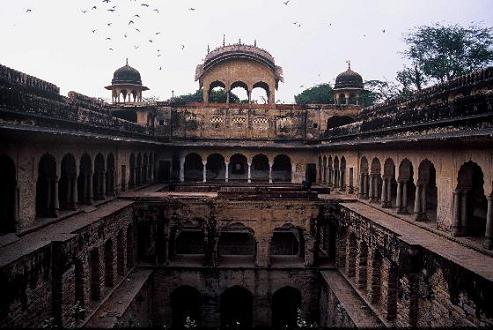 Bhandarej is a small village located around 62 kms away from the "Pink City" of Jaipur in Rajasthan. With a colorful history dating back to the 11th century, Bhandarej is also home to many temples and monuments dating back to the pre-medieval period.
Bhandarej is located in the dausa district of Rajasthan, right on the Jaipur - Agra highway. With many delightful sights and sounds surrounding it, Bhandarej is indeed a delightful place to explore. The village also has a rich tribal presence that is sure to fascinate any visitor. Meanwhile, Bhandarej is also an excellent gateway to the wildlife sanctuaries of Bharatpur, Sariska and Ranthambore.
Bhandarej is famous for walls, sculptures, decorative lattice work, terracotta utensils etc found in excavation. It is situated at about 10 Kms from the district headquarter towards Sikandra on NH-11. The Bhandarej Baori (Step Well) and Hotel Bhadravati Palace are important places to visit. The Baori is a magnificent architectural creation and has 150 wide steps going towards the main well, approximately 70 feet in width. The Palace is an interesting blend of both Mughal and Rajput architecture having courtyards, arched windows and traditionally painted verandahs.
Bhandarej is a small village located around 62 kms away from the "Pink City" of Jaipur in Rajasthan. With a colorful history dating back to the 11th century, Bhandarej is also home to many temples and monuments dating back to the pre-medieval period.
Bhandarej is located in the dausa district of Rajasthan, right on the Jaipur - Agra highway. With many delightful sights and sounds surrounding it, Bhandarej is indeed a delightful place to explore. The village also has a rich tribal presence that is sure to fascinate any visitor. Meanwhile, Bhandarej is also an excellent gateway to the wildlife sanctuaries of Bharatpur, Sariska and Ranthambore.
Bhandarej is famous for walls, sculptures, decorative lattice work, terracotta utensils etc found in excavation. It is situated at about 10 Kms from the district headquarter towards Sikandra on NH-11. The Bhandarej Baori (Step Well) and Hotel Bhadravati Palace are important places to visit. The Baori is a magnificent architectural creation and has 150 wide steps going towards the main well, approximately 70 feet in width. The Palace is an interesting blend of both Mughal and Rajput architecture having courtyards, arched windows and traditionally painted verandahs. KHAWARAOJI  Khawaraoji is famous for residence of the then rular Raoji and natural beauty. It is situated at about 25 Kms from the district headquarter towards Sikrai.
Though, it has typical way to reach this place, the fort like residence is converted into the Khawaraoji Heritage Hotel. Surrounded by hills at the three sides, and having Amol Ghati nearby with natural beauty, this place has worth to visit by tourists.
Khawaraoji is famous for residence of the then rular Raoji and natural beauty. It is situated at about 25 Kms from the district headquarter towards Sikrai.
Though, it has typical way to reach this place, the fort like residence is converted into the Khawaraoji Heritage Hotel. Surrounded by hills at the three sides, and having Amol Ghati nearby with natural beauty, this place has worth to visit by tourists.
Chand Baoli-A Stepwell Near the Harshat Mata Temple is the stepwell Chand Baoli, belonging to the 11th century AD. The desert kingdom of Rajasthan has many such tanks which served as community centres, and constructing them was considered an act of great generosity and benevolence. These baolis or stepwells were no ordinary structures; they were marvels of architecture. The Chand Baoli has beautifully carved panels inserted into the sides. The steps, in sets of 4 or 5, are in the shape of an inverted 'V'. The carved stone pillars, which are somewhat damaged now, were once strong enough for supporting pulleys to draw water. Several storeyed verandahs surround this beautiful stepwell JHAJHIRAMPURA 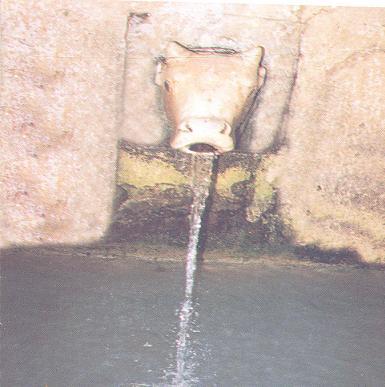 Jhajhirampura is famous for the natural water tank and temples of Rudra (Shiv), Balaji(Hanuman) and other religious god and godess. It is situated at around 45 Kms from district headquarter towards Baswa (Bandikui). Surrounded by hills and with natural water resource, this place has natural and spiritual glory.
Jhajhirampura is famous for the natural water tank and temples of Rudra (Shiv), Balaji(Hanuman) and other religious god and godess. It is situated at around 45 Kms from district headquarter towards Baswa (Bandikui). Surrounded by hills and with natural water resource, this place has natural and spiritual glory.
MEHNDIPUR BALAJI 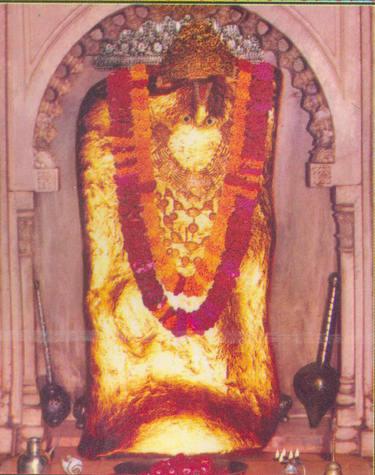 Sri Mehandipur Balaji Temple is situated in dausa,Rajasthan.Basically Shri Mehendipur Balaji Temple is Lord Hanuman Ji's Temple.Long ago the image of Lord Balaji and that of Pret Raja (the King of spirits) appeared from the Arawali hills. Now people suffering from malignant spirits and black magic or spell get their relief when they make an appeal for relief to Shri Bhairav ji and Shri Pret Raj Sarkar who holds his court and awards punishment to the malignant spirits, ghosts, goblins, ghouls, evil eyed witches etc.Shrine of Balaji, Court of Pret Raja, Pooja griha, Bhairav ji temple and Ram Darbar are some of the spots worth seeing here.
Religious ritualistic performances, charity, feeding the poor, homeless and incapacitated people, water supply for all and fodder for cows and stray animals are the activities of this temple.
Balaji temple at Mehandipur in Rajasthan is very Powerful place. It is believed that the deity in this temple has divine power to cure a person possessed with evil spirit.Hundreds of 'Sankatwalas', as the possessed people are refereed to in local lingo, throng to the temple everyday to offer prayers and have 'darshan'. The temple has also become a home and the last respite for the victims.The 'Mahant' of the temple, Shri Kishor Puri Ji, prescribes the treatment. It can include reading holy texts, following a strict vegetarian and simple diet, and even afflicts physical pain to one's body.
One can witness people going through various physical therapies like keeping heavy stones on their body , on arms, legs and chest , to ease their pain. There are others who inhale the smoke that fumes out of the sweet Patasa's kept on smoldering cowpats. The ones with serious case of spirit possession, who tends to get violent, are even shackled in chains within the temple premises.
This may appear a bit anachronistic at the first glance, but thousands of people are believed to have been cured in this way. Festival time (Holi, Hanuman Jayanti and Dusshera etc) are regarded as the most auspicious time to emancipate from the evil spirit
Medical science may discard such approach to the ailment as self-deceptions based on blind faith, but for the believers, the power of Balaji is something supernatural, something beyond metaphysics.
Sri Mehandipur Balaji Temple is situated in dausa,Rajasthan.Basically Shri Mehendipur Balaji Temple is Lord Hanuman Ji's Temple.Long ago the image of Lord Balaji and that of Pret Raja (the King of spirits) appeared from the Arawali hills. Now people suffering from malignant spirits and black magic or spell get their relief when they make an appeal for relief to Shri Bhairav ji and Shri Pret Raj Sarkar who holds his court and awards punishment to the malignant spirits, ghosts, goblins, ghouls, evil eyed witches etc.Shrine of Balaji, Court of Pret Raja, Pooja griha, Bhairav ji temple and Ram Darbar are some of the spots worth seeing here.
Religious ritualistic performances, charity, feeding the poor, homeless and incapacitated people, water supply for all and fodder for cows and stray animals are the activities of this temple.
Balaji temple at Mehandipur in Rajasthan is very Powerful place. It is believed that the deity in this temple has divine power to cure a person possessed with evil spirit.Hundreds of 'Sankatwalas', as the possessed people are refereed to in local lingo, throng to the temple everyday to offer prayers and have 'darshan'. The temple has also become a home and the last respite for the victims.The 'Mahant' of the temple, Shri Kishor Puri Ji, prescribes the treatment. It can include reading holy texts, following a strict vegetarian and simple diet, and even afflicts physical pain to one's body.
One can witness people going through various physical therapies like keeping heavy stones on their body , on arms, legs and chest , to ease their pain. There are others who inhale the smoke that fumes out of the sweet Patasa's kept on smoldering cowpats. The ones with serious case of spirit possession, who tends to get violent, are even shackled in chains within the temple premises.
This may appear a bit anachronistic at the first glance, but thousands of people are believed to have been cured in this way. Festival time (Holi, Hanuman Jayanti and Dusshera etc) are regarded as the most auspicious time to emancipate from the evil spirit
Medical science may discard such approach to the ailment as self-deceptions based on blind faith, but for the believers, the power of Balaji is something supernatural, something beyond metaphysics.
NEELKANTH & PANCH MAHADEV 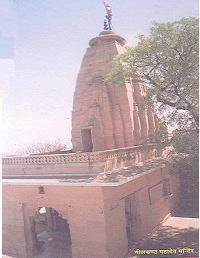 A large stone Linga , was also found whose top only is visible above the ground. It originally belonged to a Shiv Temple on the summit of the hill and a temple of Nilkanth Mahadev now occupies the site. The Temple is situated on the Aravali mountain range is at the centre of dausa district. The temple is situated at the top of a hill. The temple is said to be 100-200 years old. Rajput kings used to have security arrangements adjacent to the temple. Cannons are still seen on the temple complex. Another interesting aspect linked to faith held by the devotees is the tiny stone structures bearing the semblance of houses at the sidewalks on the way to temple. These are built by pilgrims on their way to the shrine believing that this would fulfill their wishes of having a house of their own.
dausa is also known as DEVNAGRI. In fact, Sahajnath, Somnath, Gupteshwar & Neelkanth, the five images of God Shive (Mahadev) are situated in the temples at dausa. The temple of Neelkanth, situated on the plateau of the nearby hill, shows its ancient glory and spiritual presence. The roap-way also attracts the tourists to enjoy the faith of this religious place.
A large stone Linga , was also found whose top only is visible above the ground. It originally belonged to a Shiv Temple on the summit of the hill and a temple of Nilkanth Mahadev now occupies the site. The Temple is situated on the Aravali mountain range is at the centre of dausa district. The temple is situated at the top of a hill. The temple is said to be 100-200 years old. Rajput kings used to have security arrangements adjacent to the temple. Cannons are still seen on the temple complex. Another interesting aspect linked to faith held by the devotees is the tiny stone structures bearing the semblance of houses at the sidewalks on the way to temple. These are built by pilgrims on their way to the shrine believing that this would fulfill their wishes of having a house of their own.
dausa is also known as DEVNAGRI. In fact, Sahajnath, Somnath, Gupteshwar & Neelkanth, the five images of God Shive (Mahadev) are situated in the temples at dausa. The temple of Neelkanth, situated on the plateau of the nearby hill, shows its ancient glory and spiritual presence. The roap-way also attracts the tourists to enjoy the faith of this religious place.
GATOLAV  Gatolav, at the district headquarter, is famous for the birth of Sant Sunderdas who had been preached by his master, Sant Dadudayal, the founder of Dadupanthi religion. This place has been improved for tourist purpose, particularly for swimming and boating.
Gatolav, at the district headquarter, is famous for the birth of Sant Sunderdas who had been preached by his master, Sant Dadudayal, the founder of Dadupanthi religion. This place has been improved for tourist purpose, particularly for swimming and boating.
Dulha Rai: The Valorous King Dulha Rai, the real conqueror of Dhundhar, was a youth of remarkable beauty and valour and hence got his name Dulha Rai or the bridegroom prince . His fame attracted to his banners, the voluntary support of all the spirited chiefs in the neighborhood . Dulha married the daughter of Ralhansi, the Chauhan Raja of Lalsot, and received as his wife's dowry, half the share of the fort of dausa (and its adjacent area), which his father-in-law owned. The other half belonged to a Bargujar family. After securing half of dausa Fort by marriage, Dulha Rai, with the armed help of his wife's kinsmen and no small amount of chicanery, expelled the Bargujars from their portion of dausa, and that city became the first capital of the Kachhawahs in Dhundhar land. CHURCH AT BANDIKUI  A Roman style of Chruch for Protestant Christians at Bandikui, about 35 Kms from dausa, was built up during British empire in India. This small chruch is beautiful and attractive for tourists.
A Roman style of Chruch for Protestant Christians at Bandikui, about 35 Kms from dausa, was built up during British empire in India. This small chruch is beautiful and attractive for tourists.
Haveli (Mansions) Attractions There are several small but interesting havelis(mansions) in and around dausa besides an old fort and temples The Main Temples The temples worth visiting are Sahejnathji Temple, Somnath Temple and Gupteshwar MahadeoTemple. Kaila Devi Temple Kaila Devi (Goddess) Temple is situated on the banks of the Kalisil river in Karauli district. The temple is dedicated to the tutelary diety, goddess Kaila, of the erstwhile princely rulers of the Karauli state.It is a marble structure with a large courtyard of a checkered floor.In one place are a number of red flags planted by devotees.The place is also famous for its fair held during the dark half of 'chaitra'(March-April) and lasts for a fortnight. Dargah Hazrat Khwaja Jamaluddin Shah Baba 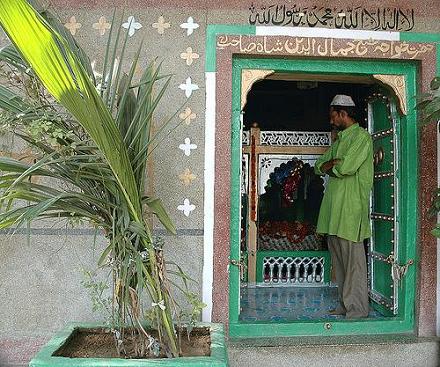 The Dargah of Hazrat Khwaja Jamaluddin Shah Baba (a dargah is the tomb of a Muslim saint) is a renowned one and is frequented by Hindus and Muslims alike, not just from within dausa but from nearby stations as well. The dargah itself is a modest building located in peaceful surroundings. It is generally believed that nobody ever returns from there without getting one's wishes fulfilled. The sleepy little town comes alive on Mondays when a special market springs up. Leather merchants from nearby places gather here to sell their camel leather goods and fine sheets of raw leather.
The Dargah of Hazrat Khwaja Jamaluddin Shah Baba (a dargah is the tomb of a Muslim saint) is a renowned one and is frequented by Hindus and Muslims alike, not just from within dausa but from nearby stations as well. The dargah itself is a modest building located in peaceful surroundings. It is generally believed that nobody ever returns from there without getting one's wishes fulfilled. The sleepy little town comes alive on Mondays when a special market springs up. Leather merchants from nearby places gather here to sell their camel leather goods and fine sheets of raw leather.
Pratap Vatika A few kilometres away from dausa lies Vair. This is where the historic Pratap Vatika spreads itself. The once-lively fort-palace complex is now in ruins, and this makes an ideal location for a quiet picnic. The Pratap Mahal with its rounded roofs and small pillared balconies is very much in keeping with Rajput architecture. Within the complex is a small temple - the Mohanji ka Mandir - made of red sandstone. Mohan is another name for Krishna, the dark and mischievous Hindu god with a flute. The arches and pillars of the temple, badly damaged, add to the romantic ambience greatly. The Lal Mahal topped by chhatris (cenotaphs) has a beautiful kund (tank) adjoining it. There are people inhabiting a part of the mahal, so all of the complex is not desolate. If not anything else, you might bump into their cows and goats at least Harshat Mata Temple 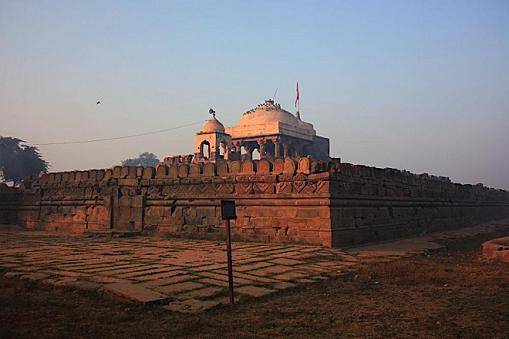 Today Abhaneri is mainly famous for the Harshat Mata Temple belonging to the 9th century. of course, only portions of this ancient shrine remain now, like the sanctuary walls, terrace and something of the columned mandapa (forechamber). The sanctum, shorn of its superstructure, is enclosed in an ambulatory and is pancharatha (with five offsets) in structure. The walls have carved niches in which are images of other deities.
These worn out images indicate that the temple was originally dedicated to Vishnu, the Creator of the Hindu trinity of Creator Preserver-Destroyer. The architectural details of the terrace basement is more or less complete, showing friezes of geometric ornament and miniature niches with sculptures of seated deities and amorous couples. The columns and walls are adorned with scenes of dance, music, sport and love, although majorly damaged now. Some of the better panels have been shifted to the Archaeological Museum, Amber and the Central Museum, Jaipur. The sanctum now enshrines an image of the four-armed deity Harasiddhi, locally called Harshat Mata. Many images of Hindu deities have been found around the place which are being preserved by the Archaelogical Survey of India. A mela (fair) is held near the temple in the month of Chaitra (March-April) every year.
Today Abhaneri is mainly famous for the Harshat Mata Temple belonging to the 9th century. of course, only portions of this ancient shrine remain now, like the sanctuary walls, terrace and something of the columned mandapa (forechamber). The sanctum, shorn of its superstructure, is enclosed in an ambulatory and is pancharatha (with five offsets) in structure. The walls have carved niches in which are images of other deities.
These worn out images indicate that the temple was originally dedicated to Vishnu, the Creator of the Hindu trinity of Creator Preserver-Destroyer. The architectural details of the terrace basement is more or less complete, showing friezes of geometric ornament and miniature niches with sculptures of seated deities and amorous couples. The columns and walls are adorned with scenes of dance, music, sport and love, although majorly damaged now. Some of the better panels have been shifted to the Archaeological Museum, Amber and the Central Museum, Jaipur. The sanctum now enshrines an image of the four-armed deity Harasiddhi, locally called Harshat Mata. Many images of Hindu deities have been found around the place which are being preserved by the Archaelogical Survey of India. A mela (fair) is held near the temple in the month of Chaitra (March-April) every year.
Mataji Ka Mandir Another group of finely carved sculptures dating back to 12th century AD that are worshipped are built in the front wall of a modern temple (built in 1965) known as Mataji ka Mandir etc. On the way to the Bawdi is the Harshd Mata Temple. It is dedicated to a goddess. It was built by King Chand or Chandra of Nikumbha Rajputs of Chahamana Dynasty who was ruling at Abaneri or ancient Abha-Nagari (City) during 8th - 9th century A.D. Facing East, this temple is raised over double terraced platform. Originally hails the super structure of the Mahameru Style. The Sanctum is Pancharatha on plan and consists of Sandhara Garbhagriha, pillared Mandapa, crowned by a domical ceiling. Each niche of the buttress of Garbagriha has beautiful Brahmanical deities. Sculptures curved in deep relief fixed in the niches around the plinth of the upper terrace are the main attraction of this temple. |

